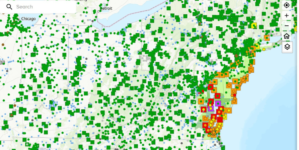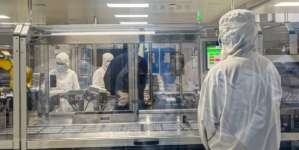-
NFL Makes Jordan Love Announcement Before Packers-Panthers - 17 mins ago
-
Prince Harry sets record straight on US citizenship plans on podcast - 21 mins ago
-
Senate approves Democratic resolution to block Trump’s tariffs on Canada - 23 mins ago
-
U.S., China hope to make progress on tariffs as Trump and Xi meet in South Korea - 36 mins ago
-
Chiefs are back in their style points era, Bills untested, Colts benefit Power of PR on Nick's Tiers - 47 mins ago
-
Santa Ana winds, heat trigger SoCal power shutoffs for thousands - 56 mins ago
-
Major flooding expected along East Coast: What to know - 57 mins ago
-
Katy Perry romance makes Justin Trudeau ‘much happier’ after split: report - about 1 hour ago
-
Inside a high-security Chinese factory pumping out fentanyl - about 1 hour ago
-
For some L.A. Latinos, ICE raids tested their Dodgers faith. Can the World Series bring them back? - 2 hours ago
AI Impact: AI May Be the Cure for Doctor Burnout, After All
Editor’s note: This is AI Impact, Newsweek’s weekly newsletter where each week, we will explore how business leaders are unlocking real value through artificial intelligence.
Tap here to get this newsletter delivered to your inbox.
Inference Layer
By Gabriel Snyder
When I came across a new study by Yale researchers showing the effectiveness of AI ambient scribes in reducing doctor burnout, I was immediately reminded of conversations I had in Sonoma last June at the Newsweek AI Impact Summit with leaders and technologists wrestling with a deceptively simple question: How do you actually measure the ROI of AI in health care, especially when the technology is evolving faster than our ability to track its impact — or even before we fully know what kinds of returns from AI we’re looking for?
The promise of AI ambient scribes—tools that listen in on patient visits and automatically generate clinical notes—has been a hot topic in health care for a while. Newsweek health care editor Alexis Kayser explored this issue in a September 2024 cover story, “Is AI the Cure for Doctor Burnout?” and in a panel discussion at our headquarters with health system leaders. The hope is that by having AI do the heavy lifting of documenting patient visits, the ambient scribes will reduce the administrative burden on physicians and their resulting burnout, thus stemming the tide of critical staffing shortages by keeping more doctors practicing medicine.
But as many speakers in Sonoma noted, the reality of proving what works in AI often lags behind the pace of innovation. As Dr. Allen Chang of UMass Memorial Health put it, “We owe it to ourselves to really prove convincingly that AI or whatever investments we make ultimately can benefit patient outcomes, and that’s a difficult thing to show.”
That’s why the new study, with lead authors Kristine D. Olson and Daniella Meeker of the Yale School of Medicine and published in JAMA Network Open, is so noteworthy. Surveying 263 clinicians across six health systems (the study is “the first large, multicenter evaluation to assess the effect of AI scribes on clinician experience”), it found that after 30 days of using an ambient scribe, the percentage of doctors reporting burnout dropped from 51.9% to 38.8%—a 74% relative reduction. Clinicians also reported less time spent on documentation after hours (so-called “pajama time”), lower cognitive load, more ability to focus on patients and a willingness to see more patients per day.
Still, it’s important to note what the study didn’t measure: long-term effects, patient outcomes and perspectives, or effects on doctors beyond self-reported surveys. As Dr. Chang pointed out, this echoes the challenge that ballooning electronic health records (EHR) introduced — the very problem ambient scribes are now being asked to fix. “Prior to the adoption of EHRs, we were on paper record systems. We believed that this is going to show amazing benefits in all sorts of ways, but after a lot of time and a heck of a lot of money, believe it or not, we have not still been able to show that EHRs, clinically, have made tremendous benefits,” Dr. Chang said. “Not because they haven’t, but because it’s difficult to show, and it’s had a lot of unanticipated consequences as well.”
So, while this new data is promising, suggesting that the hopes for AI tools may be coming to fruition, whether they help health systems reach their ultimate goal — healing patients — remains unanswered.
Upcoming Events
AI Impact Awards & Summit
The Newsweek AI Impact Awards seek to identify and recognize uniquely innovative AI solutions that solve critical business problems in different industry segments, or significantly advance capabilities. Recognition comes not from ideas, but from measurable IMPACT on business operations.
Register now – Early bird deadline ends 12/19.
Core Intelligence

Paul McDonagh-Smith, senior lecturer at the MIT Sloan School of Management, argued that the reason most AI projects fail has little to do with technology itself and everything to do with the environments into which they’re introduced. As he explained to Newsweek, organizations often treat AI as a project to implement rather than a capability to embed. The result is a proliferation of pilot programs that never scale, not because the models are flawed, but because the foundations around them are. “AI implementation isn’t the same as AI adoption,” McDonagh-Smith emphasized.
He points to three failure points that consistently appear: governance, culture and data alignment. When roles and responsibilities for AI aren’t clear, governance breaks down. When teams don’t trust or understand the systems they’re asked to use, culture stalls adoption. And when data doesn’t reflect how people make real decisions, the technology quickly becomes irrelevant.
These forces interact in subtle but powerful ways: governance determines who decides to use AI; culture shapes how people respond to it; data alignment dictates how it’s actually used. Organizations that get all three right, he notes, shift from proof of concept to purpose in production, transforming AI from a novelty into an operational backbone.
His guidance for leaders is deceptively simple: Stop chasing the next model release and start defining the decisions AI should inform. Success comes from integration, not innovation. “The hidden asset in AI isn’t the code,” he said. “It’s the connective tissue between people, process and machines.”
You can read the full article here: AI Is Not a ‘Silver Bullet’: Why Most Initiatives Falter
Prompt Injection

Owen Lloyd | VP of Software Engineering, The Nuclear Company
“You’ve got to learn and embrace this technology. You can’t be fearful of it. It’s not a scary thing — AI is just another tool, a powerful tool, but it’s another tool. You have to embrace it, but you have to use it to embrace it. That’s what I tell my kids all the time: AI is not scary. You should be using AI. You should figure out what to do, how to use it safely and appropriately. It’s going to be a building block, a fundamental building block, of the next generation. And to teach that to them, I have to show them what I’m doing with it too—and make it exciting.”
Have your own lesson to share? Email us at ai.newsletter@newsweek.com
Run Log
By Adam Mills
When catastrophic flooding struck Kerr County, Texas, in July, the state’s Department of Public Safety (DPS) faced chaos: roads were impassable, communications fragmented and families were desperate for information. “We were asked by every local, state, and federal leader what we needed,” recalled Captain John Miller of the Texas Ranger Division’s Special Operations Group. “The answer was help from Palantir… they had a team of engineers on a plane that night.”
Over the next two days, DPS and Palantir had stood up an AI-enabled Foundry environment, connecting satellite imagery, field reports and live weather data into a single dashboard. “We had a common operating picture that had never existed before,” Miller said. “We could finally tell families where to go, where not to go, and where their loved ones might be.”
The collaboration transformed what had been an ad-hoc emergency network into a predictive, data-driven operation. Using AI to fuse hundreds of feeds into one view, DPS could anticipate new flood zones and direct first responders with unprecedented precision.
What began as a crisis response has since become a model for preparedness. By pairing human coordination with machine-driven clarity, Texas DPS showed how AI can turn raw data into real-time lifesaving insight—and how technology, when deployed fast and built on trust, can restore order in the middle of disaster.
Context Window
■ Research shows the biggest barrier to enterprise AI success isn’t technology, but untapped knowledge trapped inside organizations. [Newsweek]
■ As enterprise AI spending accelerates toward a projected $1.5 trillion this year, CIOs are rethinking how they manage governance, data pipelines, and workforce readiness. This piece outlines the key steps leaders can take to keep pace in the AI age. [CIO]
■ Amazon plans to avoid hiring up to 600,000 workers by 2033 by leaning heavily on automation and AI tools to double sales without expanding its U.S. workforce. [Fox Business]
■ Meta is cutting approximately 600 jobs in its AI division as part of a push to move faster and streamline decision-making in its superintelligence lab. [Los Angeles Times]
■ OpenAI is paying ex-investment bankers to train its AI. In its “Project Mercury”, the company hired over 100 former bankers at about $150/hour to build prompts and financial models aimed at automating junior-banker tasks. [Entrepreneur]
■ Hotels and airlines are pouring money into AI, but most of it isn’t improving the traveler experience. [Newsweek]
Transfer Protocol
Chet Kapoor, former CEO of DataStax, is now vice president of Security Services & Observability at Amazon Web Services.
Ke Yang, formerly head of the “Answers, Knowledge and Information” team at Apple, is now joining Meta Platforms’s Superintelligence Labs.
Ann Bennett Dale, formerly a growth executive across Fortune 100 and PE-backed consumer-tech companies, is now chief commercial officer at Nostra.ai.
Lei Yu, formerly vice president of AI & Data at Expression, is now vice president of Artificial Intelligence and Data at General Dynamics Information Technology (GDIT).
Jon Jones, formerly vice president of Global Startups & Venture Capital at Amazon Web Services, is now chief revenue officer at CoreWeave.
Daniele Magazzeni, formerly chief analytics officer for EMEA at JPMorgan, is now chief artificial intelligence officer at UBS.
Know someone on the move in AI? Send job change info to ai.newsletter@newsweek.com
Magic Moment

Kazuki Hiraiso | Senior Data Scientist at Fujitsu
“I built an AI email agent that automatically replies to messages from my family and close friends. It drafts and sends responses on its own. Kind of cool, yeah — so even when I’m busy, it keeps up the conversation for me.”
Experience some AI magic? Tell us about it at ai.newsletter@newsweek.com
Tap here to get this newsletter delivered to your inbox.
Source link































